© 2007-2013 Bob Hackett and Sander
Kingsepp

Last Days of USS PERCH (SS-176)
By Bob Hackett and Sander Kingsepp
Rev 4
Java Sea, SE of Celebes (now Sulawesi), Dutch East Indies (now
Indonesia). On the night of 25 February 1942, LtCdr David A. Hurt's PERCH
(SS-176) was making a surface attack on a large unescorted Japanese freighter.
Just before Hurt was ready to fire torpedoes, the freighter opened fire with an
unseen deck gun. The first round missed, but before Captain Hurt could
crash-dive, the next shell hit PERCH’s conning tower fairwater and ruptured the
antennae trunk. Hurt took the submarine deep and the freighter escaped. [1]
On the night of 28 February 1942, after PERCH surfaced to recharge her
batteries and refresh the air in the boat, Captain Hurt and his crew first
learned of the Allies defeat in the Battle of the Java Sea.
PERCH and other submarines were ordered to disregard their area assignments
and proceed to attack invasion transports off Surabaya, Java.
On the night of 1 March 1942, PERCH was running on the surface on a
westward course about 35 miles NNW of Surabaya. At 0340, LtCdr Hara Tameichi’s
destroyer AMATSUKAZE’s starboard lookout seaman Ikeda Bunichi spotted an
unidentified object, bearing 30 degrees. Ikeda then shouted "positive
submarine." His identification was immediately confirmed by the forward lookout
using AMATSUKAZE’s big tripod-mounted 20-centimeter binoculars. The submarine
was about 6,560 yds/6,000 meters away. Captain Hara ordered “Battle Speed” (26
knots) and brought AMATSUKAZE right by 50 degrees and his crew to Battle
Stations. Destroyer HATSUKAZE followed.
At 2,953 yds/2,700 meters, AMATSUKAZE came around to port, brought her
guns to bear, lit her searchlight and opened fire on the submarine. Hara fired
six shells in three salvos and thought one shell hit. HATSUKAZE fired two
salvoes, but both missed. PERCH dove and disappeared before the destroyers
arrived at the spot. After the destroyers had passed well clear, they came back,
one near PERCH. Captain Hurt prepared to attack with his stern torpedo tubes,
but at 800 to 1,000 yards the destroyer turned toward him. Hurt ordered a dive
to 180 feet, but PERCH hit bottom at 147 feet. A destroyer dropped six depth
charges, then reduced speed to 12 knots and the two destroyers combed the area.
The Japanese did not pick up any targets on sonar, but the area smelled strongly
of heavy oil. At 0359, the destroyers abandoned the search and left the scene.
PERCH lost power on her port screw, but she managed to pull clear of the bottom
and surface when depth charging had ceased. [2]
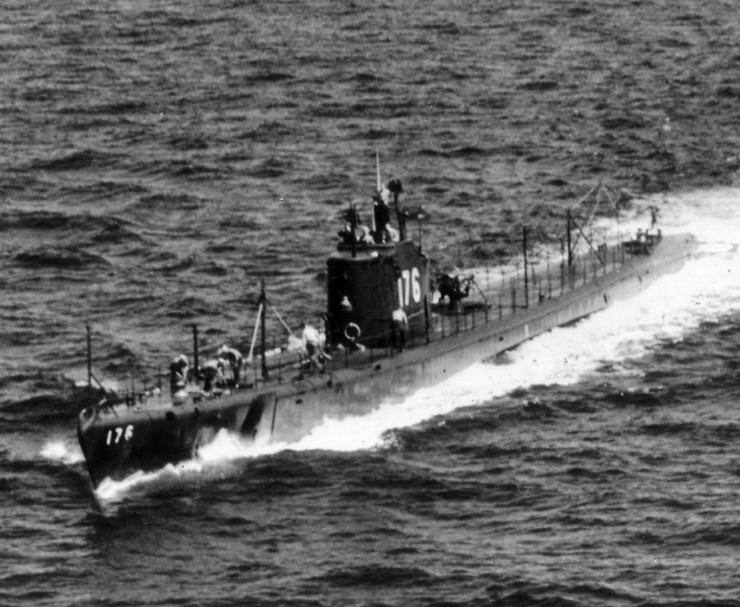
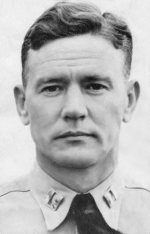
PERCH (SS-176) and her CO, LtCdr D. A. Hurt, Sr.
(Photos Courtesy of USNI & USN)
At 0549, 2 March, Lt Cdr Uesugi Yoshitake’s destroyer USHIO sighted a
large surfaced submarine (6,650 yds/6,000 m) ahead about 73 nm W of Bawean
Island. Uesugi immediately ordered full speed ahead, but when the distance had
closed to 800 m (875 yds), PERCH crash-dived to 200 feet. Efforts to move from
the bottom were unsuccessful. Five DCs were dropped at 0555 without any results.
Sonar contact was established at 0706. Betwen 0726 and 0830, 25 DCs were
dropped. This time large air bubbles broke the surface, “emitting the
characteristic stench of diesel oil", accompanied by an oil slick. Sonar contact
had been lost and USHIO left the area. Later, AMATSUKAZE returned to the same
area. Oil was still rising and stretched out for miles on the surface of the
sea.
At dusk on March 2, after an hour of effort, PERCH surfaced. No enemy
ships were in sight. Reduction gears were in bad shape, there were serious
electrical grounds and broken battery jars, and the engine room hatch leaked
badly. Arrangements were made to scuttle if necessary.
Before sunrise on 3 March 1942, while trying to dive, water poured in
from the conning tower and engine room hatches, a three-inch circulating water
line and leaks in the hull. Nothing the crew did seemed to help the leakage. At
0652, USHIO and SAZANAMI both sighted a surfaced submarine. It seemed damaged,
evidently running on one shaft and unable to dive. USHIO's CO, LtCdr Uesugi,
thought it could be a Japanese submarine and tried to contact her using a
blinker gun. There was no reply and at 0659, USHIO opened up with her
5-inch/127-mm guns at a distance of 5,250 yds/4,800 m on the target located on
her starboard bow. SAZANAMI did not open fire. [3]
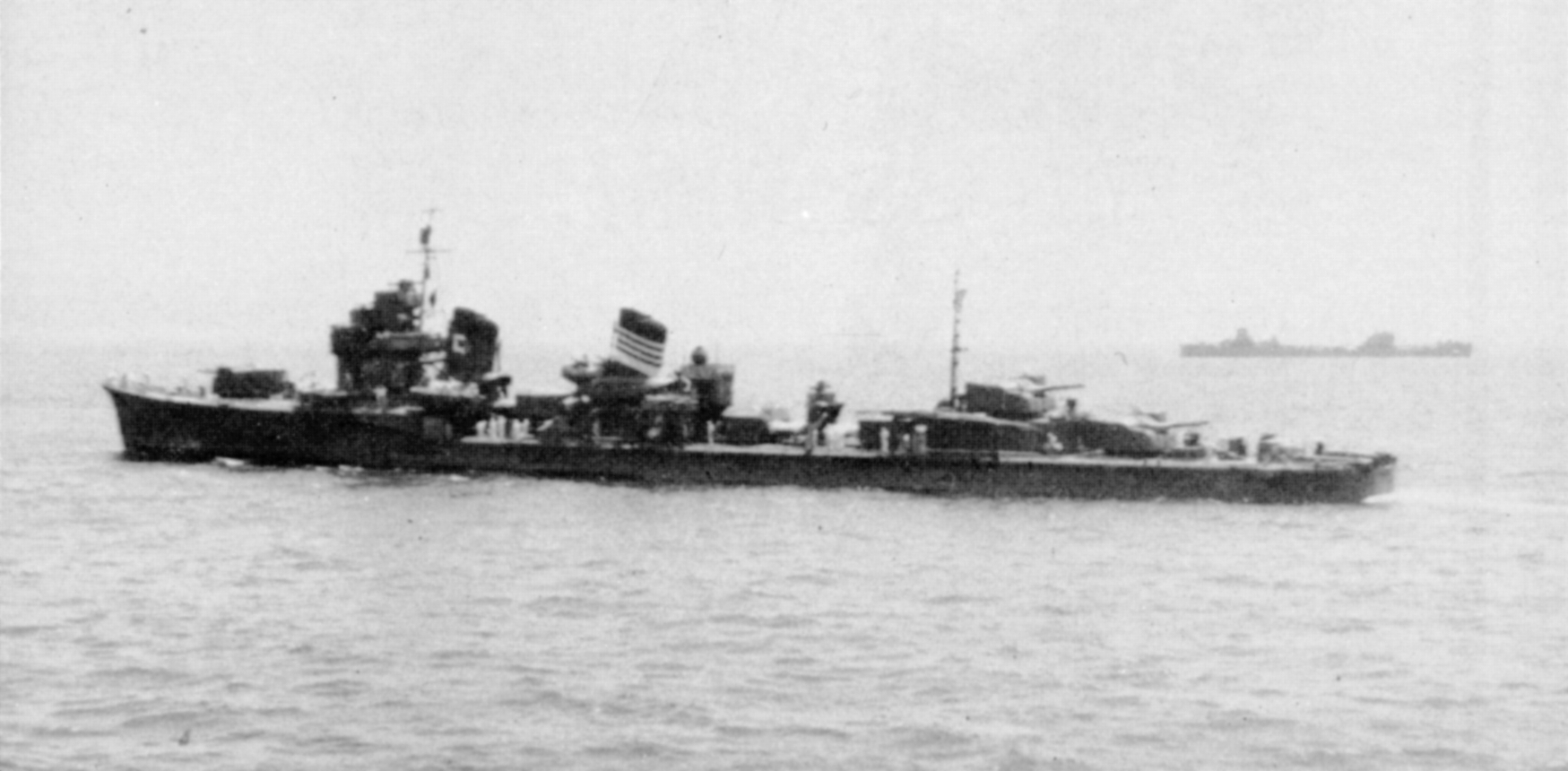
IJN Destroyer USHIO in 1942
(Maru Special)
Depth charges had wrecked PERCH and caused three of her torpedoes to run
in their tubes. Her hull was severely dimpled and her seals and gaskets leaked
so badly that she could not submerge and hope to resurface. Only one of her four
disels was operable and she was taking on water. Her deck gun could not be
elevated and her torpedoes could not be fired. She could not defend herself and
she could not run. Captain Hurt decided to abandon and scuttle. Classified
material was weighted down and dropped overboard. Lt (j.g.) Kenneth G. Schacht,
the diving officer, went aft to the engine room to open some vents, but then had
to fight his way out of the conning tower through on-rushing water. The entire
crew got into the water safely. PERCH sank quickly with her conning tower and
other hatches open to the sea. [4]
At 0716, two lifeboats from USHIO commenced a rescue operation. Hurt and
all of his crew were picked up. The Japanese sailors gave the Americans
refreshments consisting of hardtack and tea. LtCdr Uesugi sought out LtCdr Hurt
and offered his condolences on the loss of his ship.
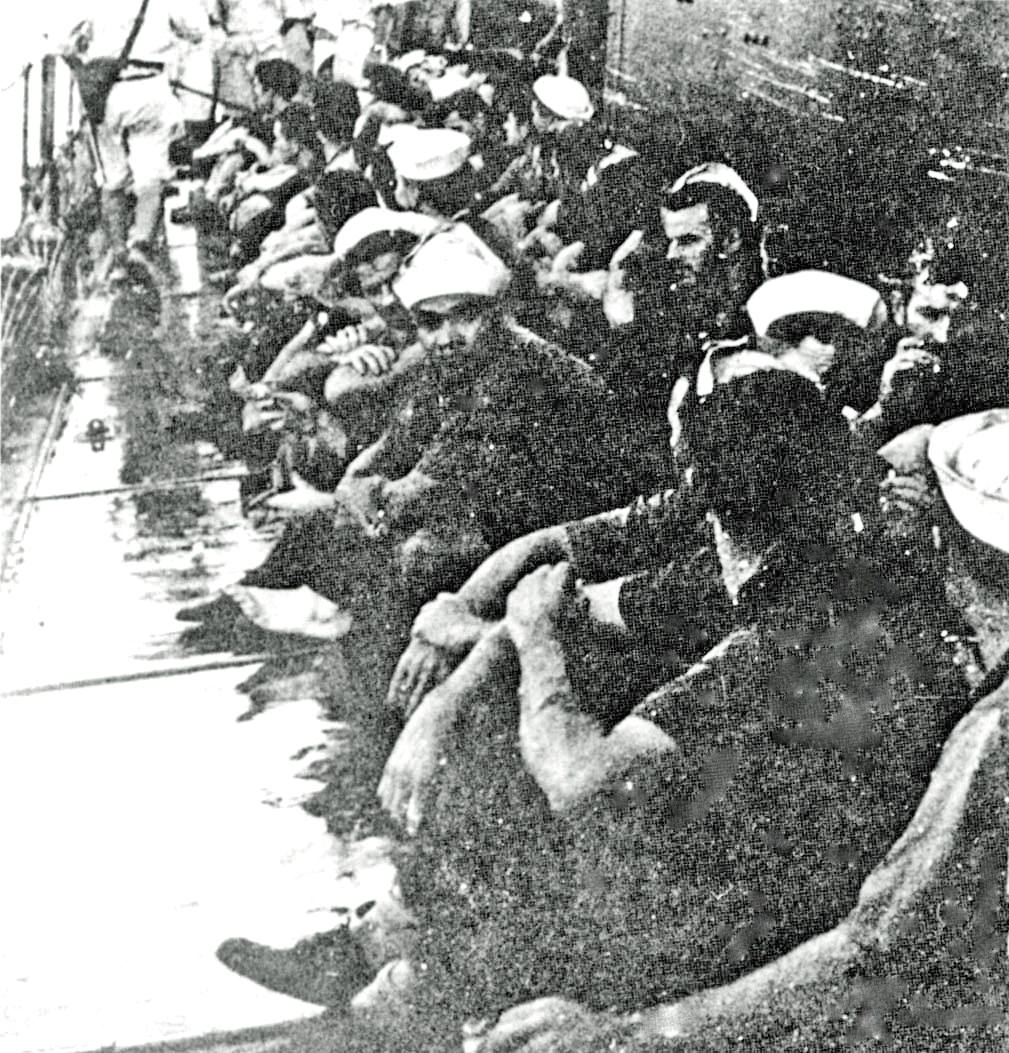 PERCH's Survivors on USHIO's Deck
(Maru Special)
The same day, LtCdr Hurt and his XO, Lt B. R. Van Buskirk, were sent to
Captain (later Rear Admiral) Ichimiya Yoshiyuki’s (former CO of ITSUKUSHIMA)
heavy cruiser ASHIGARA for interrogation. All other prisoners-of-war (POW) were
transferred to Dutch Captain G. Tuizinga’s hospital ship OP TEN NOORT nominally
still under the Dutch flag, but under Japanese orders. Later Hurt and his XO
joined their crew aboard OP TEN NOORT that was carrying 970 Allied POWs,
including about 600 survivors from heavy cruiser HMS EXETER sunk in the Battle
of the Java Sea.
On 6 March 1942, AMATSUKAZE and HATSUKAZE returned to Bandjermasin,
Borneo to replenish fuel, ammunition and supplies. While in port, LtCdr Hara
paid a call on OP TEN NOORT and observed the POWs. On March 10 1942, PERCH’s
survivors were transferred to a prison camp at Makkassar, Celebes. Eventually,
53 POWs, including LtCdr Hurt, were repatriated in September 1945. Tragically,
LtCdr Hurt was killed in a hunting accident a few months after his release. [5]
In November 2006, divers aboard MV EMPRESS, skippered by Vidar Skoglie
and using side-scan sonar, discovered PERCH sitting upright in the Java Sea at a
depth of about 190 feet/58m. One of the dive team, Australian
diver/photojournalist Kevin Denlay, states the wreck was positively confirmed as
USS PERCH (SS-176) by the builder’s plaque found and photographed still attached
to the leading edge of the conning tower. It clearly spells out “USS PERCH” and
other relevant launching data. It was placed there by the Electric Boat Co,. of
Groton, Connecticut, when she was launched on 9 May 1936. On EMPRESS return to
port at Singapore, the USN was duly notified of the discovery.
PERCH's Survivors on USHIO's Deck
(Maru Special)
The same day, LtCdr Hurt and his XO, Lt B. R. Van Buskirk, were sent to
Captain (later Rear Admiral) Ichimiya Yoshiyuki’s (former CO of ITSUKUSHIMA)
heavy cruiser ASHIGARA for interrogation. All other prisoners-of-war (POW) were
transferred to Dutch Captain G. Tuizinga’s hospital ship OP TEN NOORT nominally
still under the Dutch flag, but under Japanese orders. Later Hurt and his XO
joined their crew aboard OP TEN NOORT that was carrying 970 Allied POWs,
including about 600 survivors from heavy cruiser HMS EXETER sunk in the Battle
of the Java Sea.
On 6 March 1942, AMATSUKAZE and HATSUKAZE returned to Bandjermasin,
Borneo to replenish fuel, ammunition and supplies. While in port, LtCdr Hara
paid a call on OP TEN NOORT and observed the POWs. On March 10 1942, PERCH’s
survivors were transferred to a prison camp at Makkassar, Celebes. Eventually,
53 POWs, including LtCdr Hurt, were repatriated in September 1945. Tragically,
LtCdr Hurt was killed in a hunting accident a few months after his release. [5]
In November 2006, divers aboard MV EMPRESS, skippered by Vidar Skoglie
and using side-scan sonar, discovered PERCH sitting upright in the Java Sea at a
depth of about 190 feet/58m. One of the dive team, Australian
diver/photojournalist Kevin Denlay, states the wreck was positively confirmed as
USS PERCH (SS-176) by the builder’s plaque found and photographed still attached
to the leading edge of the conning tower. It clearly spells out “USS PERCH” and
other relevant launching data. It was placed there by the Electric Boat Co,. of
Groton, Connecticut, when she was launched on 9 May 1936. On EMPRESS return to
port at Singapore, the USN was duly notified of the discovery.

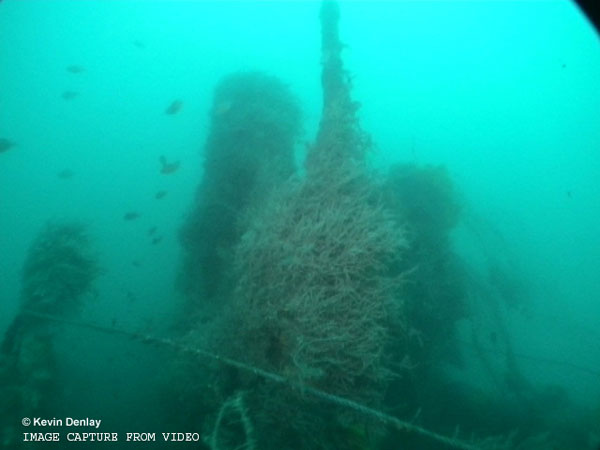
PERCH's Builder's Plaque, Periscope and Shears in 2006
(Kevin Denlay)
A slideshow of photos taken during the expedition a may be viewed at
gallery For other accounts see: on eternal patrol
and starbulletin
Author’s Notes:
Readers should note that there are a great many
inconsistencies between various accounts of what occurred during PERCH's last
fateful days. The below numbered notes cite some, not all, of the discrepancies
in the accounts.
[1] Some accounts indicate the freighter was escorted by a lone destroyer
that shelled and depth charged PERCH.
[2] Although Hara’s account of AMATSUKAZE and HATSUKAZE’s actions, and
that of author Kimata Jiro’s of USHIO and SAZANAMI, mention the destoyers
engaging PERCH with gunfire and getting possible hits, Captain Hurt’s postwar
account makes no mention of gunfire, other than PERCH being hit by a shell
earlier in February.
[3] A SAZANAMI crewman gave a vivid eyewitness account that suggested
PERCH went down after USHIO’s third salvo, when fire was checked. This number is
confirmed by USHIO's Action Report (AR) that gives the ammo expenditure in the
action as six 5-in shells and one depth charge.
[4] Postwar, Schacht was awarded a Navy Cross for denying the Japanese
access to secret gear carried by PERCH. According to an official IJN report, one
LtCdr, three Lts, one Lt (jg) and 54 enlisted sailors were picked up.
[5] Hara’s account has him visiting OP TEN NOORT on 6 Mar ’42, but other
accounts place her at Makassar, Celebes by that date. At this time, accounts
conflict as to where PERCH’s crew was imprisoned during the war. It is known
that on 10 Mar ‘42, PERCH’s survivors were transferred to a prison camp at
Makkassar, Celebes. Shortly thereafter, at least three officers, including Lt
(j.g.) Schacht, were sent to the Zentsuji POW camp on Shikoku, Japan. The
officers remained there until 25 Jun ’45 when they were transferred to the
Rokuroshi POW camp until their release on 8 Sep ’45. At least seven of PERCH’s
enlisted crewmen were transported to Japan and imprisoned in the Fukuoka-06B POW
camp at Mizumaki with other American POWs from USS POPE, MARBLEHEAD and HOUSTON
and civilians captured at Wake Island. A few enlisted crewmen were later sent to
Java. Six survivors perished as POWs of which at least four died at Makassar.
Five survivors remain in 2007.
[6] This website's Long Lancers page attributes
destroyers MINEGUMO and NATSUGUMO with damaging PERCH in a depth-charge attack
on 1 March 1942, but not when during the day this occurred.
Special thanks go Kevin Denlay of Australia and J. Ed Low of the United
States.
-Bob Hackett and Sander Kingsepp
Sources:
 English Language:
English Language:
Hara, Tameichi, Captain, IJN, Saito, Fred and Roger Pineau. "Japanese
Destroyer Captain," Ballantine Books, 1961.
Holmes, W. J., Captain, USN-Ret., “Undersea Victory: The Influence of
Submarine Operations on the War in the Pacific,” Doubleday, 1966.
Roscoe, Theodore, "United States Submarine Actions in World War II," Naval
Institute Press, Annapolis, MD, 1984.
Winslow, Walter G., Captain, USN-Ret., "The Fleet the Gods Forgot," Naval
Institute Press, Annapolis, MD, 1982.
Blair, Clay, Jr. "Silent Victory: The U.S. Submarine War Against Japan," J.
B. Lippincott Company, Philadelphia, 1975.
 Japanese Language:
Japanese Language:
Kimata Jiro. Sensuikan Kogeki (Allied Submarine Attacks). Kojinsha NF,
Bunko, 2000.
Questions or comments should be posted on the Discussion & Questions
board.










 English Language:
English Language: Japanese Language:
Japanese Language:
